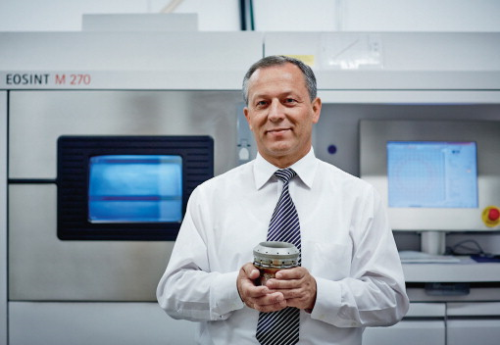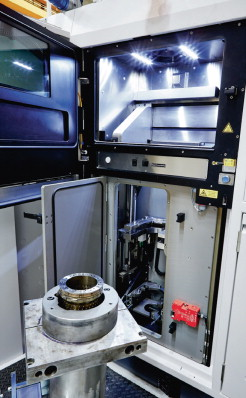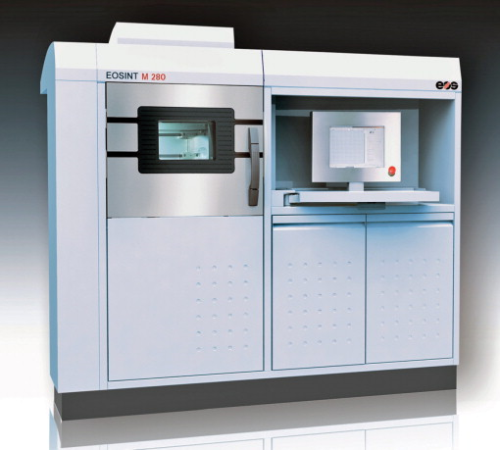


In 1852, James Prescott Joule described the physical principle of the gas turbine – the thermodynamic cycle, also known as the Joule-Process for the first time. The initial ideas and concepts behind this invention date back as early as 1791.
Siemens Industrial Turbomachinery AB manufactures gas turbines that can power between 15 and 60 MW. Besides construction, the company also provides long-term service and maintenance for the turbines. In an effort to help reduce maintenance costs, Siemens is currently working to develop and implement AM technology, using EOS technology and equipment.
Speeding up repair
The gas turbines made by Siemens consist of an air inlet, compressor, combustor, turbine and hot gas outlet. The air going through the engine is compressed by the compressor, and in the combustion chamber the compressed air is mixed with fuel and burned in order to increase the kinetic energy of the flow. In the turbine the kinetic energy of the flow is converted into mechanical energy which is used to turn the gas turbine compressor and generator (to generate electricity) or other driven equipment (e.g. the compressor to pump the gas/oil through the pipelines).
During operation the components in the engine's hot gas path are exposed to high temperatures – at times in excess of 1,000°C (e.g. blades and vanes). This can lead to a high level of wear in the hot gas path components. This is also true for the burner tip – the point at which the ignition of the fuel-air mixture takes place.
Here, the effects of wear and tear could be clearly seen and measured, and the manufacturer undertook rigorous testing to establish a prescribed operating period after which the burners typically need to be repaired.
Conventional repair procedure required prefabrication of big sections of the burner tip. This prefabricated unit is used to replace the burner tip after the specified operation time (cutting out the old one and welding on the prefabricated one). However, a conventional repair procedure can be time-consuming involving a significant number of sub-processes and examinations. To help simplify and speed up the repair procedure additive manufacturing technology was implemented at Siemens.
Metal processing
EOS was able to adapt one of its in-house machines – an EOSINT M 280 – for metal processing. The alterations concerned, in particular, the scale of the machine's interior, which had to be enlarged to accommodate the 800 mm burner. The manufacturer also amended further hardware components such as a camera system and an optical measuring system and made corresponding adjustments to the software. EOS carried out this re-working in under a year.
The EOSINT M 280 machine, launched in 2010, is an improved version of the company's previous additive manufacturing systems for metal components.
EOSINT M 280 is available with either the same 200 Watt fibre laser fitted to the EOSINT M 270, or a new 400 Watt laser for increased build speed and productivity. This higher power laser can melt more metal powder per second, achieving shorter build times and higher system productivity. This in turn can help reduce cost-per-part, raising the competitiveness of laser-sintering compared to other technologies and opening up additional application areas.
The laser sintering machine has a maximum build height to 325 mm (the EOS M 400 has a maximum built height to 400 mm). Taller parts may therefore be produced in the process chamber, expanding the range of applications, including for hybrid part building. In this hybrid process, complex parts are produced by building additional material on top of a prefabricated part.
EOSINT M 280 also has improved gas management, featuring a high velocity, laminar flow of protective gas across the entire build area and a high capacity recirculating filter system.
From the outset it was clear that the approach was reaping benefits. Rather than replacing a large portion of the burner tip, Siemens began by removing the damaged material only. Moreover during repair, former versions of the burners in the fleet could be re-built to the latest design. This meant that older fleet burner versions could not only be repaired, but also improved.
Successful result
According to EOS, various figures and data gleaned from the process detail the success of the new repair. In particular, the time required for the repair process of burner tips has reportedly fallen by more than 90%. This means that Siemens Industrial Turbomachinery will be able to make a significant impact on the reduction of the repair timeframe, since for the operator it is equally important that the turbines are quickly ready to return to service. This also opens up additional opportunities for potential cost reductions with regard to the repair process as well as maintenance.
It may also be possible for Siemens to offer its customers strategic advantages, since experts can make improvements to turbine technology by integrating the components into the repair process. In this way, operators can make use of the latest technology, even if their turbines have seen years of service.
“Additive manufacturing opens up new dimensions for us in the use of integrated design and production,” said Dr Vladimir Navrotsky, head of technology and innovation at Siemens Energy Service, Oil & Gas and Industrial Applications. “This technology enables us to manufacture and repair components for our industrial gas turbines far quicker than before. At the same time the functionality and performance of the part is increased.”
“We have successfully pushed our technology into the repair arena,” said Stefan Oswald from EOS. “We've shown that we are capable of modifying our system quickly to meet customer-specific requirements. In this case the modifications to both hardware and software were significant. Everyone involved can look back with satisfaction, not only at the end result but also the route to achieving it.”





